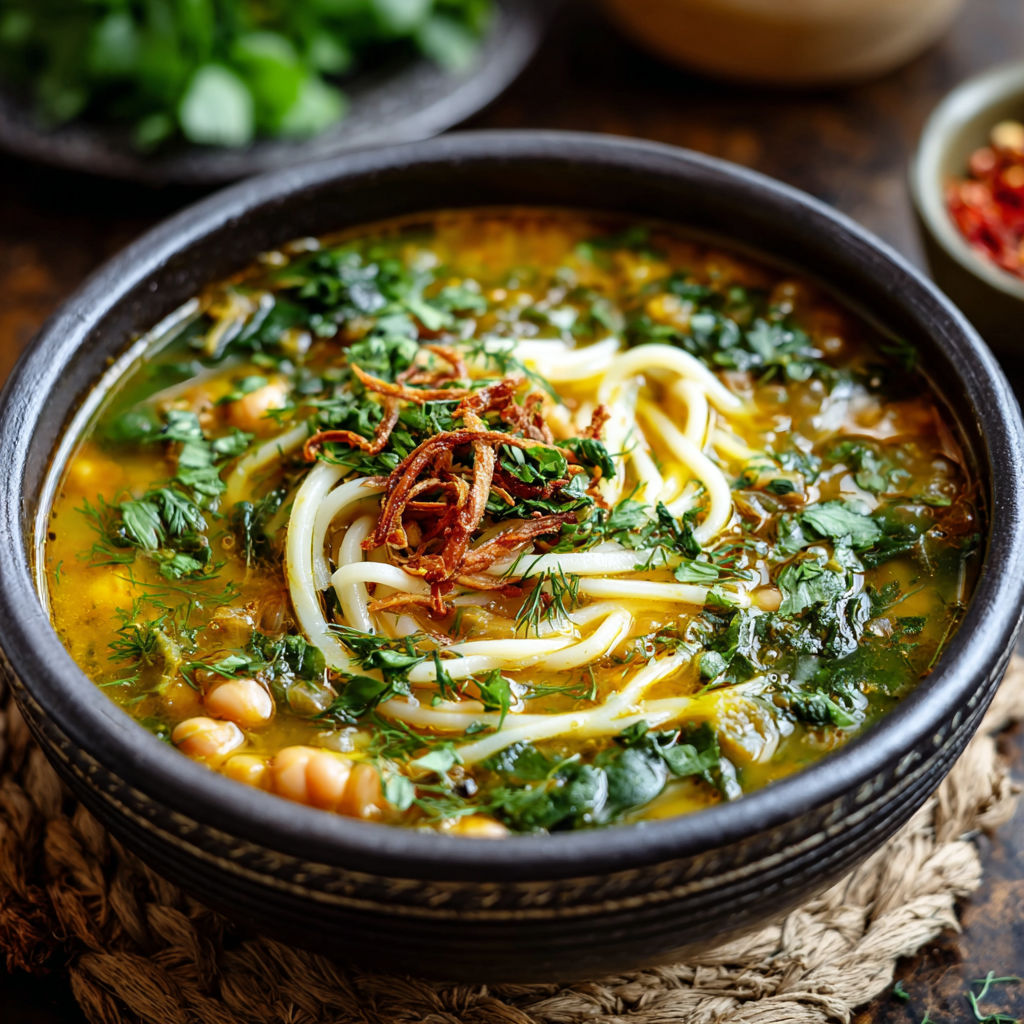 Pin it
Pin it
This Ash Reshteh blends hearty beans, soft noodles, and fragrant herbs in a truly comforting way. Every bite offers the perfect mix of earthy legumes, vibrant herbs, and soothing noodles that's made this dish a beloved part of Persian food traditions for hundreds of years.
I first tried this soup during a cold evening at my Persian buddy's place, and I couldn't believe how something so healthy could taste so amazing. Ever since, it's been my favorite thing to cook when I want to wow dinner guests with food that's both unusual and homey.
Ingredients
- Olive oil forms the tasty base where all flavors begin
- Yellow onion offers a touch of sweetness once it browns
- Fresh garlic gives important flavor depth
- Turmeric adds golden color and subtle warmth
- Vegetable broth boosts flavor without competing with the herbs
- Lentils deliver quick-cooking protein with no soaking needed
- Chickpeas bring a substantial bite and toasty flavor
- Navy beans help thicken the soup as they soften
- Kidney beans add substantial texture and deep color
- Persian noodles or linguine create the dish's classic feel
- Fresh spinach softens perfectly while boosting nutrition
- Cilantro adds freshness and authentic Persian taste
- Parsley contributes a fresh, slightly spicy note
- Fresh dill creates the signature scent this soup is known for
- Sour cream or yogurt balances everything with a bit of tang
- Fried onions for topping give that must-have crunch
How To Make Persian Noodle Soup
- Sauté the Base
- Pour olive oil into a big sturdy pot over medium heat and wait until it glistens. Toss in the chopped onion and cook them for around 5 minutes until they turn see-through and get slightly golden around the edges. Give them a stir now and then so they don't burn and cook evenly.
- Bloom the Aromatics
- Throw in the chopped garlic and turmeric with the softened onions and keep stirring for about 1-2 minutes. You'll smell the turmeric get really fragrant and the garlic should soften without turning brown. This gets all the good oils flowing from these ingredients.
- Build the Broth
- Add your vegetable broth and dump in all your beans - the lentils, chickpeas, navy beans, and kidney beans. Let it come to a light boil, then turn down the heat to keep it just bubbling. Let it cook without a lid for 20 minutes so the lentils get soft and all the flavors mix together.
- Cook the Noodles
- Drop the Persian noodles or linguine straight into your simmering soup. Stir them gently so they don't stick together and make sure they're completely covered by liquid. Let them cook about 10 minutes until they're soft but still have a tiny bit of firmness.
- Incorporate the Greens
- Add all your chopped herbs and spinach to the pot. Carefully mix them into the hot soup until they start to wilt down. Let everything bubble gently for another 5-7 minutes until the greens have completely softened and released their flavors into the soup.
- Season and Serve
- Try the soup and add salt and pepper if needed. Scoop the hot soup into warm bowls. Top each bowl with a big spoonful of sour cream or yogurt and sprinkle some crispy fried onions on top.
Don't skimp on the fresh dill - it's really what makes this dish special. I made it once when I couldn't find dill at the store, and while it was still tasty, it just wasn't the same. Later, my Persian neighbor told me that her family always judges good Ash Reshteh by how much dill goes into it.
Making Ahead and Storage
This Persian soup actually gets tastier after a day or two as everything mingles together. You can make it up to three days before you need it and keep it in the fridge. Just know that the noodles will drink up some of the liquid, so when you warm it up again, you might want to add more broth to get it back to the right thickness. If you want to keep it longer, you can freeze portions in sealed containers for up to three months, but I think it's best to freeze it without the noodles and herbs, then add fresh ones when you heat it up.
Adaptations and Substitutions
Even though traditional Ash Reshteh calls for certain ingredients, this soup can handle changes based on what you've got at home. Can't find Persian noodles? Just break up some linguine or fettuccine into smaller pieces. Don't worry if you're missing a certain type of bean. No kidney beans around? Just use twice as many navy beans instead. Short on fresh herbs? Try half as much dried herbs, but add them earlier while cooking. Want to add meat? Just brown some ground lamb or beef with the onions at the start.
 Pin it
Pin it
Traditional Serving Suggestions
In Persian homes, folks usually serve this soup with several extras that make it even better. The crispy fried onions aren't just for show - they add a necessary crunch that makes each bite more interesting. The tangy yogurt or sour cream on top brings a creamy richness that works really well with the earthy beans. Serve it with warm flatbread like lavash or sangak for dipping. Many Persian families also put out a small plate of fresh herbs, radishes, and feta cheese on the side, so everyone can customize their soup with extra fresh stuff as they eat.
 Pin it
Pin it
Frequently Asked Questions
- → Can I try other beans in this dish?
Absolutely! Swap in any beans you'd like, such as pinto, cannellini, or black beans. It's all about keeping the variety for texture and nutrition.
- → What works instead of Persian noodles?
Linguine can be swapped with other long pastas like fettuccine or angel hair. For gluten-free options, try rice noodles or even quinoa—just keep an eye on different cooking times.
- → How do I make crispy onion topping?
Slice onions thinly and warm 1/4 cup of oil in a pan over medium heat. Fry until they turn golden while stirring. Drain well on paper towels and sprinkle a little salt while they're hot.
- → Can this dish be prepped in advance?
Totally! It's better the next day as flavors deepen. Cook it, but hold off on adding fresh herbs or noodles until you're reheating. The base can chill in the fridge for up to 3 days or freeze for 3 months.
- → How do I make it creamier?
Blend a portion of the soup’s beans with broth for a creamy texture. You can also stir in extra yogurt or add coconut milk for richness and a new twist on flavor.
- → What can I use if I’m missing some herbs?
If you’re short on cilantro, parsley, or dill, sub in fresh mint or basil. Fresh herbs are best, but in a pinch, small amounts of dried herbs will do—just adjust to taste.
